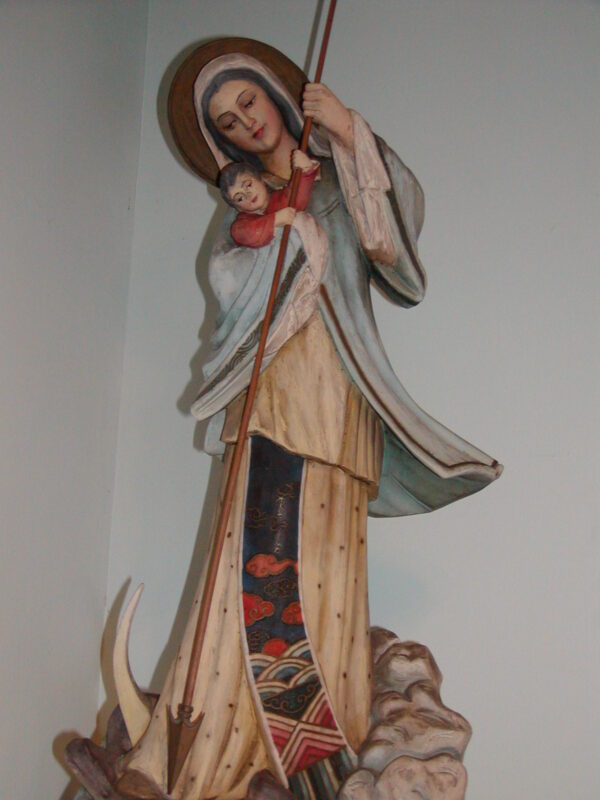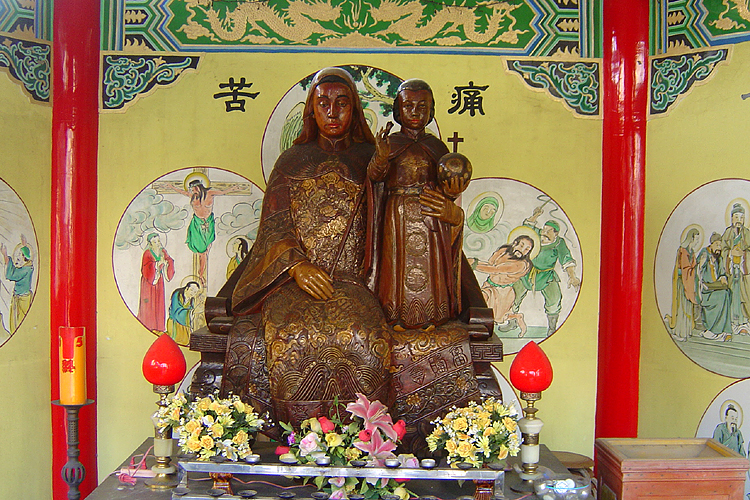
China Bridge (神州橋樑)_2007/May
Images of Our Lady of China
Numerous Catholic churches in China have a Marian title: Assumption, Holy Mother, Immaculate Conception, Immaculate Heart, Queen of Peace, Rosary and Our Lady of Sorrows, of the Nativity, of Lourdes, or of China. What’s missing?
There is no church named after Guadalupe, since China is far from Mexico; nor Medjugore, since the Vatican has not certified those apparitions; and certainly not Fatima, as the messages of 1917 were distinctly anti-communist. A mainland parish with that name would be asking for trouble.
However, both in Macau and on Cheung Chau Island, Hong Kong, there is a church named after Fatima, and both conduct pilgrimages on May 13. In the new era, the names of those two churches have also continued unchanged, just like streets named after old colonial governors.
The Chinese face of Mary

It took the early Church a few centuries of heated debates and councils, plus countless prayers, to correctly discern the balance between the divine and human natures of Christ. Then they argued about the role of the Blessed Mother in God’s plan. How all of this was translated or mistranslated into other languages and cultures is a difficult question.
Scholars have published a few volumes on The Chinese Face of Jesus, to document how Our Lord was portrayed in religious art, how his message was presented and even how traditional Chinese comparisons and phrases were employed in translating the Gospel. If anyone were to write The Chinese Face of Mary, it would be a thinner book, but just as ancient.
From the arrival of the Syrian monk Alopen in Tang (唐) China in 635AD, missionaries, who proclaimed Jesus, also mentioned his Mother Mary reverently. Her name appears on the 2.8 metre tall limestone tablet of the Luminous Religion, Jing Jiao (景教), which was carved in 781.
An unexpected visitor in the museum
A dozen years ago, a priest from southern India stopped in Hong Kong on his way to China. He belonged to the Assyrian Church, the Church of the East, often but incorrectly called the Nestorian Church. Nestorius had a problem with the proclamation of Mary’s Divine Maternity by the Council of Ephesus in 431.

The Church of the East sent missionaries on long trips overland to China and across the sea to India. When one of their modern spiritual descendants visited the Holy Spirit Study Centre, he did not say, “I’m not a Nestorian because…” Rather he said, “These are questions for scholars, but in preaching to the people we avoid technical terms. We tell stories instead,” including stories of Holy Mary.
Then he went to the Hong Kong airport and continued his pilgrimage to the ancient tablet. In Xi’an, the museum staff were shocked when the priest introduced himself. They thought the Jing Jiao was extinct like the dinosaurs. But there he was talking, taking photos, and buying souvenirs, totally unlike a fossil.
Early Churches struggle to take root in China
The Church of the East never had huge numbers in China, but it adapted the styles of Chinese art and literature. Maybe that was a mistake. After a few centuries, Christian writings in Chinese had so many Buddhist and Taoist terms sprinkled on the page that it was hard to see a distinctly Biblical outlook. We’ll never know for sure, but scholars suspect that this was one reason the Church of the East faded away in China after a few centuries. Becoming too much at home in the local culture can bring danger to the Church.
Franciscans missionaries under Archbishop John of Montecovino (1247-1328) had a vibrant church in Beijing during the Yuan dynasty (元朝) but it was largely for Mongolians and for other groups from north and west of the Great Wall. With the restoration of native rule by the Ming dynasty (明朝) in 1368 and the expulsion of minority groups, that Church was forgotten. If the missionaries had reached out to the Han (汉) majority, then the history of the Catholic Church in East Asia might have been radically different. God knows!
Marian shrines
Devotion to Our Lady is not a dry issue reserved for historians or theologians. The footsteps of faithful on pilgrims, their songs, gazing at statues, carvings and paintings, and even the time they spent on their knees, all shaped the living faith of the Church. Over the centuries, the sense of the Catholic faithful carried forward belief in the Immaculate Conception and the Assumption until the solemn papal proclamations of 1854 and 1950.
Pilgrims in China visit many Marian shrines. Our Lady of Sorrows in Banshi, Taiyuan, Shanxi (山西太原板寺), and Longtian in Fuzhou, Fujian (福建福州龙田) are well known. For tourists, Help of Christians in Sheshan in suburban Shanghai (上海舍山), is easy to reach. Donglu Village is not far from the large city of Baoding in Hebei (河北保定东閭村), but in terms of accessibility, the map is deceptive. Donglu has been a rallying point for the unofficial Church, with several police raids and numerous arrests having occurred on Marian feast days over the years. Given the close surveillance, foreigners should do that local church a favor and pray from a distance. Donglu is still too politically sensitive for tour buses.
Paintings with Chinese characteristics
Three and four centuries ago some converts prepared woodcuts to illustrate the early Chinese catechisms. Our Lady is always shown with her robe covering her feet, an old convention in depicting women. In the 1930s a group of painters in Beijing used Chinese architecture and clothing for a series of Gospel scenes. Then war scattered those artists.
In one untitled painting, Our Lady is praying while standing on a lotus, which is in a quiet patch of water, undisturbed by waves.
Most of the paintings have a column or two of Chinese characters in commentary. A Flight into Egypt, mentions leaving home to seek warmth and peace. A mountain ridge is half covered in mist and the moon by clouds.
In Both teacher and son, the Holy Word is attentive, Baby Jesus is seated on a high chair, with a book open to Alpha and Omega. He looks up at his mother.
Mother of Life, Source of Living Water, shows Mother Mary holding Baby Jesus, both of whom are focused on an apple in his hand. They are serenely oblivious to a long snake trapped under her robe. Behind them is a cross in bloom, with leaves and apples.
Mother Upholds His Steps, He Happily Descends into the World, shows Our Lady bending slightly forward, holding the upraised arms of Jesus, who looks like he needs some support to take tentative steps down the steps, away from their thatched house.
At first glance, The Holy Sages looks more Buddhist than Christian. Standing on dry ground, Our Lady holds her son. Immediately behind of her, and not much taller, is a tree is covered with flames. A jagged mountain towers in the background. It reminds one of Moses seeing a burning bush at Mount Horeb (Ex. 3:1-3). Yet the halo of fire around mother and child looks like the halo around the Buddha in a temple. That is creative, yes, especially before Vatican II. But how far should Catholic art go in the direction of Buddhist iconography?
Catholics in Taiwan still buy Christmas cards reproducing these paintings, but they do not sell on the mainland.
On the contrary, most mainland Catholics shake their heads at such pictures. They prefer the Holy Family as shown in western art, with European features. Why? Perhaps because their government often reminds them that the Catholic faith is a “foreign” religion which needs to become more Chinese. One slogan is “love country and love religion” (爱国爱教).
Instead of “God and country,” the country comes first in China. In preferring a western style of art and architecture, China’s Catholics remind themselves that they belong to an international Church. They are indirectly or subconsciously making a political statement.
On the other hand, the new stained glass windows in the Shanghai cathedral display bamboo, pine and Chinese characters. Catholic art on the mainland is becoming more Chinese, but not as quickly as among Protestants.
After a little searching, many examples of Chinese Christian visual art can be found on the Internet.
Oh clement, oh sweet Virgin Mary
A generation ago, a young, healthy, and financially secure Catholic in the United States of America asked a thoughtless question. “Who can pray the Salve Regina today? That line about ‘mourning and weeping in this valley of tears’ is so medieval. Who believes that any more? Life in the modern world is good.” Now he is no longer young and perhaps neither healthy nor rich. Is he having second thoughts?
About 20 years ago, when the Four Modernisations were picking up speed in China, Protestant Bishop Ding Guangxun (丁光訓) of Nanjing (南京) said, “Communists want China to be strong one day, with everyone educated, healthy and prosperous. So do I! When that day comes, they predict that religion will disappear. They may be right. We’ll see! But if we Christians are right, then people will still have needs which Christianity can fulfill.”
In 2007, the whole world has more computers, automobiles and overall wealth than ever before, but two or three billion people feel left out of the economic boom. The number of lonely and elderly people is growing, not to mention the pollution statistics. We have not yet created heaven on earth. In China, there is a rising interest in spirituality, while among young and old Catholics devotion to the Mother of God remains strong. Holy Mary, Mother of God, pray for us sinners, now and at the hour of our death. Amen.
MJ


 ENG
ENG